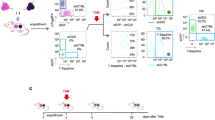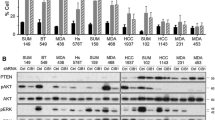Abstract
RNA interference offers therapeutic opportunities for the clinical targeting of otherwise undruggable oncogenes. However RNAi can have off-target effects that considerably increase treatment risks. To manage these side effects and allow an easy subtraction of their activity in healthy tissues, we present here the TAG-RNAi approach where cells that are not designated targets do not have the mRNA tag. Using TAG-RNAi we first established the off-target signatures of three different siRNAs specific to the Cyclin D1 oncogene by RNA-sequencing of cultured cancer cells expressing a FLAG-HA-tagged-Cyclin D1. Then, by symmetrical allografts of tagged-cancer cells and untagged controls on the left and right flanks of model mice, we demonstrate that TAG-RNAi is a reliable approach to study the functional impact of any oncogene without off-target bias. Finally we show, as examples, that mutation-specific TAG-RNAi can be applied to downregulate two oncogenic mutants, KRAS-G12V or BRAF-V600E, while sparing the expression of the wild-type proteins. TAG-RNAi will thus avoid the traditional off-target limitations of RNAi in future experimental approaches.




Similar content being viewed by others
References
Mohr SE, Smith JA, Shamu CE, Neumuller RA, Perrimon N. RNAi screening comes of age: improved techniques and complementary approaches. Nat Rev Mol Cell Biol. 2014;15:591–600.
Pasquinelli AE. MicroRNAs and their targets: recognition, regulation and an emerging reciprocal relationship. Nat Rev Genet. 2012;13:271–82.
Fire A, Xu S, Montgomery MK, Kostas SA, Driver SE, Mello CC. Potent and specific genetic interference by double-stranded RNA in Caenorhabditis elegans. Nature. 1998;391:806–11.
Wu SY, Lopez-Berestein G, Calin GA, Sood AK. RNAi therapies: drugging the undruggable. Sci Transl Med. 2014;6:240ps7.
Kanasty R, Dorkin JR, Vegas A, Anderson D. Delivery materials for siRNA therapeutics. Nat Mater. 2013;12:967–77.
Morrison C. Alnylam prepares to land first RNAi drug approval. Nat Rev Drug Discov. 2018;17:156–7.
Setten RL, Rossi JJ, Han SP. The current state and future directions of RNAi-based therapeutics. Nat Rev Drug Discov. 2019;18:421–46.
Tabernero J, Shapiro GI, LoRusso PM, Cervantes A, Schwartz GK, Weiss GJ, et al. First-in-humans trial of an RNA interference therapeutic targeting VEGF and KSP in cancer patients with liver involvement. Cancer Discov. 2013;3:406–17.
Xue W, Dahlman JE, Tammela T, Khan OF, Sood S, Dave A, et al. Small RNA combination therapy for lung cancer. Proc Natl Acad Sci USA. 2014;111:E3553–61.
McDonald ER 3rd, de Weck A, Schlabach MR, Billy E, Mavrakis KJ, Hoffman GR, et al. Project DRIVE: a compendium of cancer dependencies and synthetic lethal relationships uncovered by large-scale, deep RNAi screening. Cell. 2017;170:577–92 e10.
McFarland JM, Ho ZV, Kugener G, Dempster JM, Montgomery PG, Bryan JG, et al. Improved estimation of cancer dependencies from large-scale RNAi screens using model-based normalization and data integration. Nat Commun. 2018;9:4610.
Tsherniak A, Vazquez F, Montgomery PG, Weir BA, Kryukov G, Cowley GS, et al. Defining a cancer dependency map. Cell. 2017;170:564–76 e16.
Berns K, Hijmans EM, Mullenders J, Brummelkamp TR, Velds A, Heimerikx M, et al. A large-scale RNAi screen in human cells identifies new components of the p53 pathway. Nature. 2004;428:431–7.
Jackson AL, Linsley PS. Recognizing and avoiding siRNA off-target effects for target identification and therapeutic application. Nat Rev Drug Discov. 2010;9:57–67.
Kok FO, Shin M, Ni CW, Gupta A, Grosse AS, van Impel A, et al. Reverse genetic screening reveals poor correlation between morpholino-induced and mutant phenotypes in zebrafish. Dev Cell. 2015;32:97–108.
Rossi A, Kontarakis Z, Gerri C, Nolte H, Holper S, Kruger M, et al. Genetic compensation induced by deleterious mutations but not gene knockdowns. Nature. 2015;524:230–3.
Stainier DY, Kontarakis Z, Rossi A. Making sense of anti-sense data. Dev Cell. 2015;32:7–8.
Bienvenu F, Jirawatnotai S, Elias JE, Meyer CA, Mizeracka K, Marson A, et al. Transcriptional role of cyclin D1 in development revealed by a genetic-proteomic screen. Nature. 2010;463:374–8.
Zampieri A, Champagne J, Auzemery B, Fuentes I, Maurel B, Bienvenu F. Hyper sensitive protein detection by Tandem-HTRF reveals Cyclin D1 dynamics in adult mouse. Sci Rep. 2015;5:15739.
Yu Q, Sicinska E, Geng Y, Ahnstrom M, Zagozdzon A, Kong Y, et al. Requirement for CDK4 kinase function in breast cancer. Cancer Cell. 2006;9:23–32.
Lehmann S, Relano-Gines A, Resina S, Brillaud E, Casanova D, Vincent C, et al. Systemic delivery of siRNA down regulates brain prion protein and ameliorates neuropathology in prion disorder. PLoS ONE. 2014;9:e88797.
Zwijsen RM, Wientjens E, Klompmaker R, van der Sman J, Bernards R, Michalides RJ. CDK-independent activation of estrogen receptor by cyclin D1. Cell. 1997;88:405–15.
Casimiro MC, Crosariol M, Loro E, Ertel A, Yu Z, Dampier W, et al. ChIP sequencing of cyclin D1 reveals a transcriptional role in chromosomal instability in mice. J Clin Investig. 2012;122:833–43.
Yu Q, Ciemerych MA, Sicinski P. Ras and Myc can drive oncogenic cell proliferation through individual D-cyclins. Oncogene. 2005;24:7114–9.
Alt JR, Cleveland JL, Hannink M, Diehl JA. Phosphorylation-dependent regulation of cyclin D1 nuclear export and cyclin D1-dependent cellular transformation. Genes Dev. 2000;14:3102–14.
Prenen H, Tejpar S, Van Cutsem E. New strategies for treatment of KRAS mutant metastatic colorectal cancer. Clin Cancer Res. 2010;16:2921–6.
Cantwell-Dorris ER, O’Leary JJ, Sheils OM. BRAFV600E: implications for carcinogenesis and molecular therapy. Mol Cancer Ther. 2011;10:385–94.
Birmingham A, Anderson EM, Reynolds A, Ilsley-Tyree D, Leake D, Fedorov Y, et al. 3’ UTR seed matches, but not overall identity, are associated with RNAi off-targets. Nat Methods. 2006;3:199–204.
Sheridan C. Billion-dollar deal propels RNAi to CNS frontier. Nat Biotechnol. 2019.
Anderson KR, Haeussler M, Watanabe C, Janakiraman V, Lund J, Modrusan Z, et al. CRISPR off-target analysis in genetically engineered rats and mice. Nat Methods. 2018;15:512–4.
Zhou C, Sun Y, Yan R, Liu Y, Zuo E, Gu C, et al. Off-target RNA mutation induced by DNA base editing and its elimination by mutagenesis. Nature. 2019;571:275–8.
Lander ES, Baylis F, Zhang F, Charpentier E, Berg P, Bourgain C. et al. Adopt a moratoriumon heritable genome editing. Nature. 2019;567:165–8.
Yin H, Xue W, Anderson DG. CRISPR-Cas: a tool for cancer research and therapeutics. Nature Reviews Clinical Oncology. 2019;16:281–95.
Khan AA, Betel D, Miller ML, Sander C, Leslie CS, Marks DS. Transfection of small RNAs globally perturbs generegulation by endogenous microRNAs. Nature Biotechnology. 2009;27:549–55.
Guo RL, Lee YT, Byrnes C, Miller JL. Puromycin selection confounds the RNA-Seq profiles of primary human erythroblasts. Transcriptomics. 2017;5.
Hanahan D, Weinberg RA. Hallmarks of cancer: the next generation. Cell. 2011;144:646–74.
Kirk R. Targeted therapies: model reveals addiction to oncogenes. Nat Rev Clin Oncol. 2011;8:691.
Iribe H, Miyamoto K, Takahashi T, Kobayashi Y, Leo J, Aida M, et al. Chemical modification of the siRNA seed region suppresses off-target effects by steric hindrance to base-pairing with targets. ACS Omega. 2017;2:2055–64.
Acknowledgements
For kind gifts we thank: P. Sicinski for the tagged-CycD1 animals, Ccnd1−/− cells, and pBABE-PURO vector, S. Chouaib for the MCF7 cells, Montpellier SIRIC for the kind gift of HT-29 and SW-620 cells, L. Le Cam for the pL56-Ras vector, O. Ayrault for the kind gift of MSCV vector, and J. Pannequin for the kind gift of BRAF antibodies. We thank Dr J.C. Maurel, Dr P. Maurel, Dr Elsa Compte, Dr Caroline Bauer, and Mrs Lorraine Benigno for their help with in vivo siRNA delivery. The Aonys® vector, used to administer the siRNAs in mice, was kindly provided, for free, by the Medesispharma company. Medesispharma did not financially contribute to this work and has no conflict of interest in this study.
Funding
This work was supported by the Atip-Avenir program (RSE11003FSA), the Merieux Research Grant (060805), the FP7 Marie-Curie European IRG (277118), the EpiGenMed LabEx (“investissements d’avenir” référence ANR-10-LABX-12–01), the Fondation pour la Recherche Médicale, the Ligue Nationale and Régionale contre le Cancer, the University of Montpellier, the SATT AxLR, the Montpellier SIRIC, and the Cancéropôle GSO, all to FB. JC is the recipient of a Ligue Nationale contre le Cancer Ph.D. fellowship.
Author information
Authors and Affiliations
Contributions
JC performed experiments with the help of BM, LKL, MM, AZ, IF, AD, and FB. IF performed the screening for siRNAs specific to FLAG and HA tags helped by AZ. AZ did the tandem-HTRF measures with the help of MM and JC. AD did the clonogenic assays and D-Cyclins immunoblots with the help of JC. LKL performed the in vivo experiments in immune-compromised mice helped by BM, JC, and MM. JC did the RNAi treatments for RNA-Seq experiments and prepared total RNAs. DS prepared and processed the RNA-Seq libraries and ED processed the raw RNA-Seq data. FB analyzed the DESeq2 data with the help of AD. MM did the screening for G12V and V600E-specific siRNAs with the help of AZ and JC. FB designed the TAG-RNAi strategy, directed the study, analyzed the data, and wrote the manuscript. FB is the inventor of patents WO2018134305A1, WO2017009588A1, WO2017009587A1, and WO 2016046508A1.
Corresponding author
Ethics declarations
Conflict of interest
The authors declare that they have no conflict of interest.
Additional information
Publisher’s note Springer Nature remains neutral with regard to jurisdictional claims in published maps and institutional affiliations.
Rights and permissions
About this article
Cite this article
Champagne, J., Linares, L.K., Maurel, B. et al. TAG-RNAi overcomes off-target effects in cancer models. Oncogene 39, 935–945 (2020). https://doi.org/10.1038/s41388-019-1020-2
Received:
Revised:
Accepted:
Published:
Issue Date:
DOI: https://doi.org/10.1038/s41388-019-1020-2
- Springer Nature Limited
This article is cited by
-
Exploring the DNA damage response pathway for synthetic lethality
Genome Instability & Disease (2022)
-
Advances in synthetic lethality for cancer therapy: cellular mechanism and clinical translation
Journal of Hematology & Oncology (2020)




